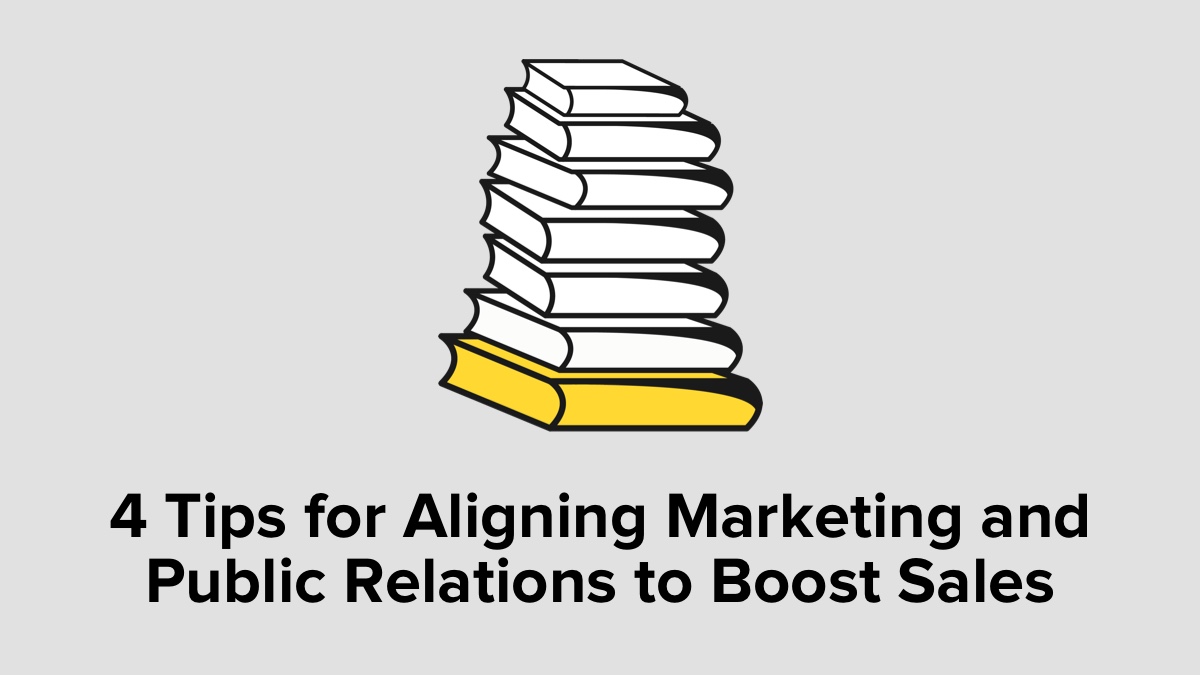4 Tips for Aligning Marketing and Public Relations to Boost Sales

Marketing and PR (Public Relations) have more recently began to become one and the same, and many seasoned industry experts are being asked to preform the roles and functions of each. While these functions often work in tandem, they have their own goals and methodologies. As you build your overall marketing plan and budget for the year, you need to also consider how to align your marketing and PR strategies to amplify your company's reach, create brand awareness, and drive measurable results.
Here's a guide to help you understand the similarities and differences between PR and marketing and how you can achieve great success using their combined powers to build an effective marketing & PR roadmap.
Marketing vs PR
Before we dive into the nitty-gritty, let us understand how both these terms are defined.
Marketing is the act of promoting or creating awareness about a product, service, or company with the direct intention of increasing sales and brand recognition. Marketing includes researching the market, the competition, understanding the various channels to reach out to target customers, and crafting brand messages and advertising to grow its sales and overall image.
Public Relations, or PR, is the professional maintenance of a favorable public image of the company, its people, and its products.
Here is a table simplifying the similarities and differences between PR and marketing:
| Parameters | PR | Marketing |
| Messaging | Defines the best channels to publicize marketing material & messaging to the media | Creates & owns brand messaging and what is to be communicated to the audience |
| Media Relations | Owns and maintains cordial relations with media contacts, publications, and important connections with whom the organization should stay in touch | Not required to directly interface with the media; as marketing usually hands over the messaging to PR for outreach |
| Target customer | Not involved in knowing the target customer; PR teams only need to be aware of the channels the target customer is using | Marketing owns and defines target persona depending on the market research and ideal requirements of their customers |
| Focus | Creating a positive brand image and amplifying media coverage | Increasing revenue and sales for the company by meeting marketing targets |
Tips For Aligning Your Marketing & PR As An Effective Unit
Now that we've touched upon the differences and ownership of marketing and PR, let us understand how these functions fit the organization to achieve its goals. While there are innumerable marketing and public relations best practices to be aware of, defining the overall strategy will require a focused approach.
To help you get started, here are a few tips to steer you in the right direction:
Define Your Organizational Goals
What is your organization currently focused on? Is it generating new business, gearing up for a round of funding, or is it launching a new product or service? Depending on your company's goal, your marketing and PR teams need to prioritize their plans.
For instance, if you plan to launch a new product, the PR team will need to start creating its roadmap and outreach plan. In contrast, the marketing team focuses on creating content, emails, and social media campaigns to maximize outreach.
Know The Target Audience
Whether you are a B2B or a B2C company, knowing your audience is key. Marketing and PR need this information to ensure that the right messaging and outreach are created for the audience. So while you may know who your target customers are, make sure to revise this target audience as per the needs, requirements, and features of your company's services or products.
Having a defined target persona will help the marketing team plan their outreach campaigns and messaging based on this information. Meanwhile, PR will be researching the key publications and media contacts who have a following among this audience, ensuring an effective outreach.
Align Your Brand Messaging
Now that your target audience is known, marketing and PR need to ensure that the right messaging reaches the right audience. Remember, the one size fits all approach doesn't always work. For increased conversion, you need to give your audience the value they are looking for.
For example, an investor will want to know your company's performance in the last quarter, while a prospect would want to know the offerings to help meet requirements. To make sure you are providing the right messaging to each audience segment, marketing and PR need to craft messaging and strategy that's beneficial for the overall company tone. So create a messaging for each audience and leverage it for the appropriate audience type.
Follow A Set Protocol For Information Exchange
Finally, to ensure that marketing and PR teams work efficiently, your company needs to follow a set protocol. Define the roles and responsibilities for both the teams and ensure effective coordination. In most organizations, both marketing and PR report to a single manager, who can be the Chief Marketing Officer or Brand Manager. This helps them work efficiently and manage dependencies as required.
It is also highly suggested that companies have regular catchup sessions to ensure inter-dependencies are managed, and there are no roadblocks to the organization's outreach.
________
Loved our content? If you want more tips, tricks, and industry advice from us, sign up for our monthly newsletter powered by exclusive journalist insights, industry experts, and lots of coffee!
If you want to learn more about public relations, be sure to check out Your Essential Guide to Public Relations to learn about why PR matters, how to create an effective strategy, what KPIs you should be tracking, and so much more.
Want more blogs like this?
Click below to subscribe to our newsletter and receive emails with the top blogs from The TypeBar!
